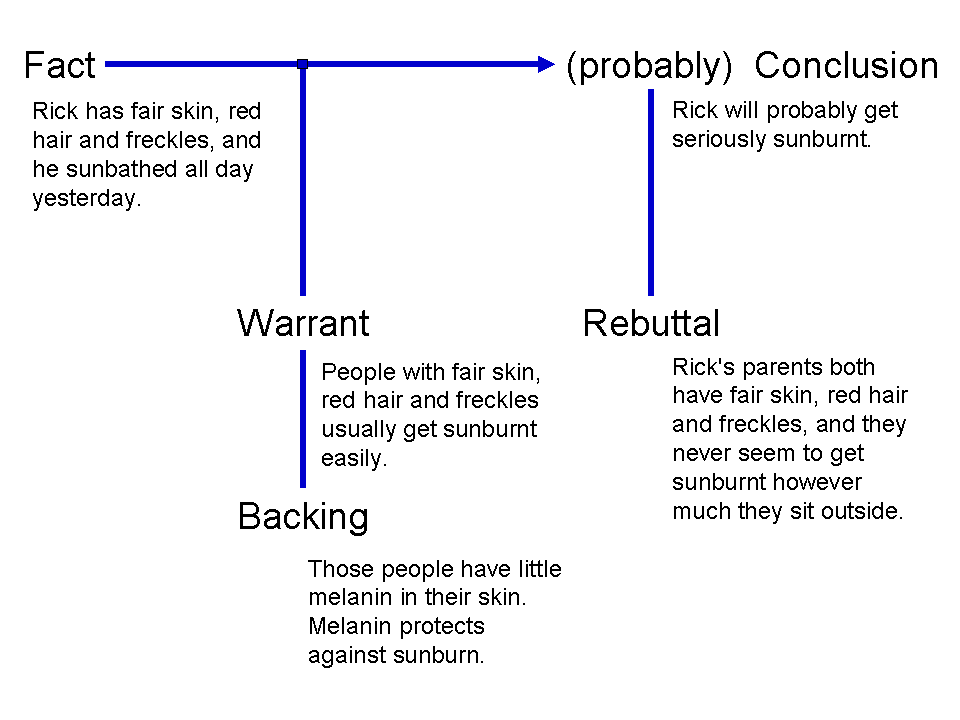How can I effectively present my argument?
In order for your argument to be sound, consider an organizational structure that the target audience perceives as both logical and easy to follow or understand (to parse). Three argumentative methods (i.e., the Classical Method, the Toulmin Method, and the Rogerian Method) provide ways of organizing ideas when forming an argument.
[!note] The three methods listed below are the most popular models for organizing an argument. Alternatives exist, so always be sure to ask your instructor if you are considering anything other than the three methods described below. For those taking Thesis Seminar, consider combining the classical method overall and the Toulmin Method when developing a body paragraph.
Classical Method
The Classical Method of structuring an argument is another common way to organize your points. Originally devised by the Greek philosopher Aristotle (and then later developed by Roman thinkers like Cicero and Quintilian), classical arguments tend to focus on issues of definition and the careful application of evidence. Thus, the underlying assumption of classical argumentation is that, when all parties understand the issue perfectly, the correct course of action will be clear.
Components and Structure – The classical argument is made up of five components, which are most commonly composed in the following order:
- Exordium – The introduction, opening, or hook.
- Narratio – The context or background of the topic.
- Proposito and Partitio – The claim/stance and the argument. Consider a thesis statement as the main claim or stance of the entire academic text.
- Confirmatio and/or Refutatio – positive proofs and negative proofs of support. Consider an initial claim, counterclaim, and rebuttal.
- Peroratio – The conclusion and call to action. – 💡 Although an option, a Point-by-Point method of organizing one’s ideas will be the preferred method over the Classical (Block) Method approach. Again, the recommended method for organizing your academic text (e.g., five-paragraph essay, literature review, etc.) will be the Toulmin Method as described above. Adhering to the Toulmin Method does not ignore modes of persuasion and components of structure.
Toulmin Model
For those taking Thesis Seminar, include claims, grounds, warrants, counterclaims, and rebuttals throughout your text. For those writing a shorter academic text (e.g., a five-paragraph essay, etc.), include claims, grounds and warrants when following the MEAL Plan. Check with your instructor if counterclaims, rebuttals, etc. are also necessary.
Benjamin L. Stewart

The Toulmin Method allows writers to construct a sound and organized set of ideas “intended to focus on the justificatory function of argumentation” (Wikipedia). The key takeaway: consider why or the process of justification when trying to link evidence to certain claims. ## Toulmin Method Format and Examples Claim (i.e., conclusion, thesis statement, topic sentence, the main idea, proposition, assertion, main argument, initial argument, etc. ):
- Example of a claim: Manufacturing hybrid cars provide an effective strategy to fight pollution. Grounds (i.e., evidence, facts, data, examples, statistics, etc.): You should use evidence to support the claim. In other words, provide the reader with facts, data, examples, statistics, etc. that prove your argument is strong.
- Example of grounds (Data1): Driving a car is a typical citizen’s most air-polluting activity.
- Example of grounds (Data 2): Each vehicle produced is going to stay on the road for roughly 12 to 15 years.
- Example of grounds (Data 3): Hybrid cars combine a gasoline engine with a battery-powered electric motor.
Warrant Warrant (i.e., bridge, analysis, synthesis, comment, explanation, justification, opinion, etc. ): In this section, you explain why or how your data supports the claim. As a result, the underlying assumption that you build your argument on is grounded in reason.
- Example of a warrant 1: Due to the fact that cars are the largest source of private (as opposed to industrial) air pollution, switching to hybrid cars should have an impact on fighting pollution.
- Example of a warrant 2: Cars generally have a long lifespan, meaning that the decision to switch to a hybrid car will make a long-term impact on pollution levels.
- Example of a warrant 3: The combination of these technologies produces less pollution.
Backing Backing (i.e., foundation): Here, you provide any additional logic or reasoning that may be necessary to support the warrant.
- Counterclaim: Anticipate a counterclaim that negates the main points in your argument. Don’t avoid arguments that oppose your own. Instead, become familiar with the opposing perspective. If you respond to counterclaims, you appear unbiased (and, therefore; you earn the respect of your readers). You may even want to include several counterclaims to show that you have thoroughly researched the topic.
- Example of a counterclaim: Instead of focusing on cars, which still encourages an inefficient culture of driving even as it cuts down on pollution, the nation should focus on building and encouraging the use of mass transit systems.
- Rebuttal: In this section, you incorporate your own evidence that disagrees with the counterclaim. It is essential to include a thorough warrant or bridge to strengthen your essay’s argument. If you present data to your audience without explaining how it supports your thesis, your readers may not make a connection between the two, or they may draw different conclusions.
- Example of a rebuttal: While mass transit is an idea that should be encouraged, it is not feasible in many rural and suburban areas, or for people who must commute to work. Thus, hybrid cars are a better solution for much of the nation’s population.
See also A claim defined and A premise defined.
Rogerian Method
The Rogerian Method is a form of argumentative writing that aims to establish a middle ground between parties with opposing viewpoints or goals. It is based on the work of psychotherapist Carl Rogers, who believed that communication and empathy are essential for resolving conflicts. Unlike other methods of argumentation, such as the Classical or Toulmin methods, the Rogerian Method does not seek to persuade the audience by proving the validity of one position over another. Instead, it focuses on finding and acknowledging the overlapping interests, values, and assumptions of both sides, and then proposing a shared solution that satisfies the common needs of both parties. The Rogerian Method can be useful for addressing controversial or sensitive topics, as it can reduce hostility and increase cooperation among the participants. However, it may not be effective for situations where there is no room for compromise, or where one side is clearly wrong or unreasonable.
A typical structure of a Rogerian argument essay comprises the following sections:
- Introduction: In this section, the writer introduces the topic and provides some background information. The writer also states their own position on the issue, but making no claims or judgments. This section establishes the context and relevance of the issue, and to show respect for the opposing viewpoint.
- Summary of the Opposing Views: In this section, the writer presents a fair and accurate summary of the main points and arguments of the opposing view. The writer should avoid any criticism or evaluation of the opposing view, and instead show that they have listened and understood it. This section shows empathy and recognition for the other side, and to build trust and rapport with the audience.
- Statement of Validity: In this section, the writer acknowledges that the opposing view has some validity or merit in certain situations or contexts. The writer should identify and explain the areas where they agree with or can accept the opposing view, and provide evidence or examples to support their statement. This section shows the writer is open-minded and willing to consider different perspectives, and to narrow down the scope of disagreement.
- Statement of Position: In this section, the writer restates their own position on the issue, but without repeating or contradicting what they said in the introduction. The writer should emphasize how their position differs from or complements the opposing view, and provide evidence or examples to support their statement. This section clarifies and assert the writer’s own viewpoint, and to show how it relates to the other side.
- Statement of Context: In this section, the writer explains under what conditions or circumstances their position would be more appropriate or preferable than the opposing view. The writer should also acknowledge any limitations or drawbacks of their position, and address any potential objections or counterarguments from the other side. This section shows the writer is aware of the complexity and diversity of the issue, and to qualify their position accordingly.
- Statement of Benefits: In this section, the writer proposes a shared solution or a common course of action that would benefit both sides. The writer should explain how their solution would address the needs and interests of both parties, and how it would improve the situation or resolve the conflict. This section shows the writer is collaborative and constructive, and to appeal to the values and goals of both sides.
By following this structure, a Rogerian argument essay can effectively present a balanced and respectful case that fosters dialogue and understanding between opposing parties.
Closing thoughts…
Organizing an argument – that is, organizing your thesis paper – relates more to writing style than it does to the mechanics of writing. Most of the feedback I provide English language learning writers relates to writing style than it does to mechanics. Also, I provide feedback that relates to writing style first, before providing feedback about mechanics. Writing style relates to the choice of words, choice of sentence structure, and choice of paragraph structure whereas mechanics relates to spelling, grammar, and punctuation (Wikipedia).
A claim defined and A premise defined: Consider the following as different claims: your thesis statement, topic sentences from body paragraphs, assertions from outside sources that serve as evidence (or grounds) for broader claims, the reporting of findings from your own research, and your interpretation of your findings. More specific claims that support more broad claims are called premises. A sound argument contains premises that lead to broader claims that align to the main idea of your paper. Consider this when writing your literature review: the evidence sentences (or grounds) support the topic sentence of the body paragraph. The body sentences of the paragraph support the level II heading that marks your two-to-four subsections of your literature review. The level II headings (or subsections) should align with your thesis statement. In terms of your results and discussion section, your findings (direct quotations, statistics, observations, responses to questionnaires, etc.) should align or support the topic sentence of each body paragraph. Each body paragraph should align with the respective level II heading (subsection). Each level II heading should relate directly to a set of research questions and/or a hypothesis. The thesis statement should answer the research questions and/or be aligned with the hypothesis.

